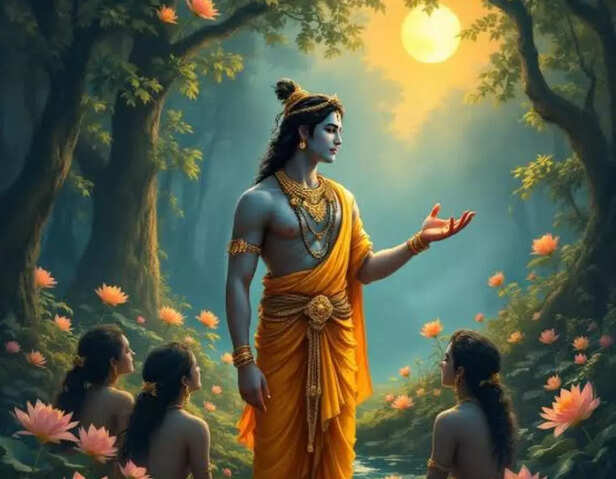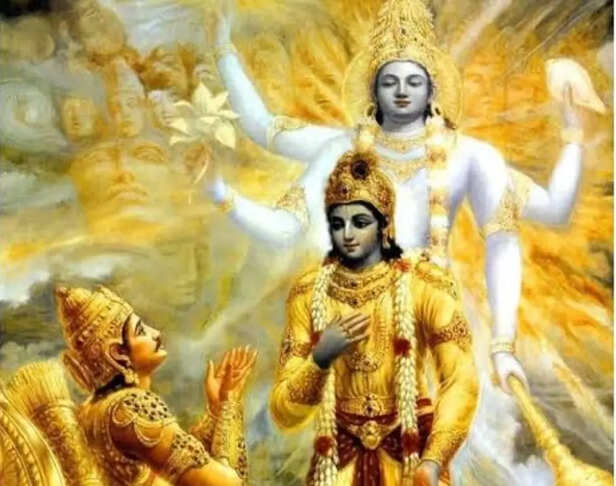Pain Isn’t the Problem—It’s the Portal (The Gita Reveals Why)
Ankit Gupta | May 26, 2025, 18:18 IST
The Bhagavad Gita transforms our understanding of pain, revealing it as a gateway to self-realization rather than a burden. Through Krishna’s guidance to Arjuna, pain becomes a catalyst for inner awakening, dharma, and spiritual strength.
“दुःखेष्वनुद्विग्नमना: सुखेषु विगतस्पृह:।
वीतरागभयक्रोध: स्थितधीर्मुनिरुच्यते॥”
(Gita 2.56)
“One who remains undisturbed in sorrow, free from desire in pleasure, and who is free from attachment, fear, and anger — such a sage is called steadfast in wisdom.”

In the modern world, pain is seen as the enemy — something to be avoided, numbed, escaped. Yet The Bhagavad Gita, the ancient Indian scripture delivered by Krishna to Arjuna on the battlefield of Kurukshetra, sees it differently. According to the Gita, pain is not the problem — it is the portal. It is the beginning of awakening, not the end of joy.
Pain is the shock that shakes us out of illusion. When Arjuna stands paralyzed by sorrow and confusion before the great war, Krishna does not remove the pain. He transforms it. Pain becomes the doorway to realization. Without Arjuna's anguish, the Gita would never have been spoken.
Krishna does not coddle Arjuna with platitudes. He doesn’t say, “It’s okay, your feelings are valid.” Instead, he says:
“क्लैब्यं मा स्म गमः पार्थ नैतत्त्वय्युपपद्यते।”
“Yield not to this unmanliness, O Partha. It does not befit you.” (Gita 2.3)
This is a wake-up call. Pain is not a punishment from God. It is a divine disruption of delusion. The Gita teaches that sorrow is not to be worshipped, but understood — because in understanding pain, we outgrow it.
Pain shows us the limits of pleasure. It cracks the shell of false identity. In Arjuna’s breakdown, Krishna shows us the breakthrough.

The Gita repeatedly uses the term “duḥkha” – suffering. But Krishna’s aim is not to eliminate suffering through external control. He points inward. He says that sorrow doesn’t arise from situations, but from confusion about identity.
“न त्वेवाहं जातु नासं न त्वं नेमे जनाधिपा:।”
“There was never a time when I did not exist, nor you, nor all these kings.” (Gita 2.12)
This radical statement destroys the basis of pain: the illusion of mortality and separateness. Our pain stems from the belief that we are bodies, egos, roles — and that their loss is loss of self. Krishna says: No. You are not this pain. You are the witness of it.
In Chapter 2, Krishna teaches Arjuna that the Self is indestructible, untouched by birth, death, pleasure or pain. The warrior must rise beyond personal emotion to dharma — the cosmic order. Pain is not a roadblock to duty, but its invitation.
When Arjuna says, “I shall not fight,” Krishna doesn’t soothe him. He says:
“अशोच्यानन्वशोचस्त्वं प्रज्ञावादांश्च भाषसे।”
“You speak wise words, but you grieve for what is not worthy of grief.” (Gita 2.11)
Pain is valid, but it is not the truth. It is a veil. When pierced, it reveals a deeper Self beyond fear and failure.

Why does Krishna call the enlightened one “sthitaprajña”, the one of steady wisdom? Because they no longer react to pain as their pain. Pain becomes information, not identification.
The Gita teaches a powerful psychological transformation:
“मात्रास्पर्शास्तु कौन्तेय शीतोष्णसुखदु:खदा:।
आगमापायिनोऽनित्यास्तांस्तितिक्षस्व भारत॥”
“Contacts with matter give rise to cold and heat, pleasure and pain; they come and go. Bear them bravely.” (Gita 2.14)
This verse is not denial of emotion. It is emotional mastery. It calls for titiksha — the spiritual endurance that does not resist pain, but witnesses it as a passing wave.
In modern terms, this is emotional resilience. The Gita doesn’t ask us to suppress suffering. It asks us to outgrow the idea that we are defined by it.
Just as gold is purified by fire, so is the soul by sorrow. But the fire does not destroy the gold. It removes its impurities.
When we stop running from pain, it reveals our indestructibility. This is the essence of Yoga: not escape, but union through understanding.

A question arises: if pain is a portal, why do we suffer repeatedly? Why do some suffer more than others? The Gita answers through the law of karma — not as fate, but feedback.
“स्वधर्मे निधनं श्रेय: परधर्मो भयावह:”
“Better to die in one’s own dharma than to follow another’s path with fear.” (Gita 3.35)
Suffering intensifies when we abandon our inner nature. When we mimic others, suppress our truth, or act from ego, we accumulate inner friction — and that expresses as suffering.
Yet Krishna is not deterministic. He offers hope:
“सर्वधर्मान्परित्यज्य मामेकं शरणं व्रज।”
“Abandon all forms of dharma and surrender unto Me alone.” (Gita 18.66)
This is the supreme shift: from effort to surrender, from control to connection. When we stop resisting pain and offer it to the Divine — pain becomes sacred.
Suffering becomes sadhana. When offered to Krishna, sorrow purifies. Pain, in devotion, becomes tapas — spiritual fire that refines, not ruins.
Arjuna began the Gita as a broken warrior. He ends it as a transformed sage. His pain was not removed — it was transfigured. That is the gift of Krishna: not to numb us, but to ignite us through pain.
Pain is not your punishment. It is your portal. A cosmic initiation.
The next time pain visits — do not ask, “Why me?” Ask, “What is this trying to awaken in me?”
As the Gita shows: the greatest revelations come not in pleasure, but in profound discomfort. For in the cracking of the ego, the light of the Self shines through.
And then, we no longer run from pain — we walk through it into wisdom.
वीतरागभयक्रोध: स्थितधीर्मुनिरुच्यते॥”
(Gita 2.56)
“One who remains undisturbed in sorrow, free from desire in pleasure, and who is free from attachment, fear, and anger — such a sage is called steadfast in wisdom.”
The Purpose of Pain – Not Punishment, but Passage

Testament to Pain
( Image credit : Pexels )
In the modern world, pain is seen as the enemy — something to be avoided, numbed, escaped. Yet The Bhagavad Gita, the ancient Indian scripture delivered by Krishna to Arjuna on the battlefield of Kurukshetra, sees it differently. According to the Gita, pain is not the problem — it is the portal. It is the beginning of awakening, not the end of joy.
Pain is the shock that shakes us out of illusion. When Arjuna stands paralyzed by sorrow and confusion before the great war, Krishna does not remove the pain. He transforms it. Pain becomes the doorway to realization. Without Arjuna's anguish, the Gita would never have been spoken.
Krishna does not coddle Arjuna with platitudes. He doesn’t say, “It’s okay, your feelings are valid.” Instead, he says:
“क्लैब्यं मा स्म गमः पार्थ नैतत्त्वय्युपपद्यते।”
“Yield not to this unmanliness, O Partha. It does not befit you.” (Gita 2.3)
This is a wake-up call. Pain is not a punishment from God. It is a divine disruption of delusion. The Gita teaches that sorrow is not to be worshipped, but understood — because in understanding pain, we outgrow it.
Pain shows us the limits of pleasure. It cracks the shell of false identity. In Arjuna’s breakdown, Krishna shows us the breakthrough.
Duhkha as a Catalyst

From Despair to Dharma
The Gita repeatedly uses the term “duḥkha” – suffering. But Krishna’s aim is not to eliminate suffering through external control. He points inward. He says that sorrow doesn’t arise from situations, but from confusion about identity.
“न त्वेवाहं जातु नासं न त्वं नेमे जनाधिपा:।”
“There was never a time when I did not exist, nor you, nor all these kings.” (Gita 2.12)
This radical statement destroys the basis of pain: the illusion of mortality and separateness. Our pain stems from the belief that we are bodies, egos, roles — and that their loss is loss of self. Krishna says: No. You are not this pain. You are the witness of it.
In Chapter 2, Krishna teaches Arjuna that the Self is indestructible, untouched by birth, death, pleasure or pain. The warrior must rise beyond personal emotion to dharma — the cosmic order. Pain is not a roadblock to duty, but its invitation.
When Arjuna says, “I shall not fight,” Krishna doesn’t soothe him. He says:
“अशोच्यानन्वशोचस्त्वं प्रज्ञावादांश्च भाषसे।”
“You speak wise words, but you grieve for what is not worthy of grief.” (Gita 2.11)
Pain is valid, but it is not the truth. It is a veil. When pierced, it reveals a deeper Self beyond fear and failure.
The Inner Alchemy of Pain

From Reaction to Realization
Why does Krishna call the enlightened one “sthitaprajña”, the one of steady wisdom? Because they no longer react to pain as their pain. Pain becomes information, not identification.
The Gita teaches a powerful psychological transformation:
“मात्रास्पर्शास्तु कौन्तेय शीतोष्णसुखदु:खदा:।
आगमापायिनोऽनित्यास्तांस्तितिक्षस्व भारत॥”
“Contacts with matter give rise to cold and heat, pleasure and pain; they come and go. Bear them bravely.” (Gita 2.14)
This verse is not denial of emotion. It is emotional mastery. It calls for titiksha — the spiritual endurance that does not resist pain, but witnesses it as a passing wave.
In modern terms, this is emotional resilience. The Gita doesn’t ask us to suppress suffering. It asks us to outgrow the idea that we are defined by it.
Just as gold is purified by fire, so is the soul by sorrow. But the fire does not destroy the gold. It removes its impurities.
When we stop running from pain, it reveals our indestructibility. This is the essence of Yoga: not escape, but union through understanding.
Karma, Suffering, and the Supreme Shift

Rags to Riches
( Image credit : Freepik )
A question arises: if pain is a portal, why do we suffer repeatedly? Why do some suffer more than others? The Gita answers through the law of karma — not as fate, but feedback.
“स्वधर्मे निधनं श्रेय: परधर्मो भयावह:”
“Better to die in one’s own dharma than to follow another’s path with fear.” (Gita 3.35)
Suffering intensifies when we abandon our inner nature. When we mimic others, suppress our truth, or act from ego, we accumulate inner friction — and that expresses as suffering.
Yet Krishna is not deterministic. He offers hope:
“सर्वधर्मान्परित्यज्य मामेकं शरणं व्रज।”
“Abandon all forms of dharma and surrender unto Me alone.” (Gita 18.66)
This is the supreme shift: from effort to surrender, from control to connection. When we stop resisting pain and offer it to the Divine — pain becomes sacred.
Suffering becomes sadhana. When offered to Krishna, sorrow purifies. Pain, in devotion, becomes tapas — spiritual fire that refines, not ruins.
From Battlefield to Blissfield
Pain is not your punishment. It is your portal. A cosmic initiation.
The next time pain visits — do not ask, “Why me?” Ask, “What is this trying to awaken in me?”
As the Gita shows: the greatest revelations come not in pleasure, but in profound discomfort. For in the cracking of the ego, the light of the Self shines through.
And then, we no longer run from pain — we walk through it into wisdom.
